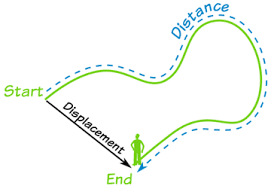Motion and its type

Introduction to Motion When we talk about motion or rest it is with reference to some point known as the origin. So, now with respect to the change in the position we have two quantities which can be used to describe that change in position. They are distance and displacement. So now the question is, what is the difference between the two? Talking about distance, it is defined as the total path length covered during the motion. It can be represented only by magnitude. On the other hand, displacement is the shortest distance between the initial and final position. It requires both magnitude and direction for complete representation. What is Motion? We can define motion as the change of position of an object with respect to time. A book falling off a table, water flowing from the tap, rattling windows, etc all exhibit motion. Even the air that we breathe exhibits motion! Everything in the universe moves. We live in a universe that is in continual motion. ...
